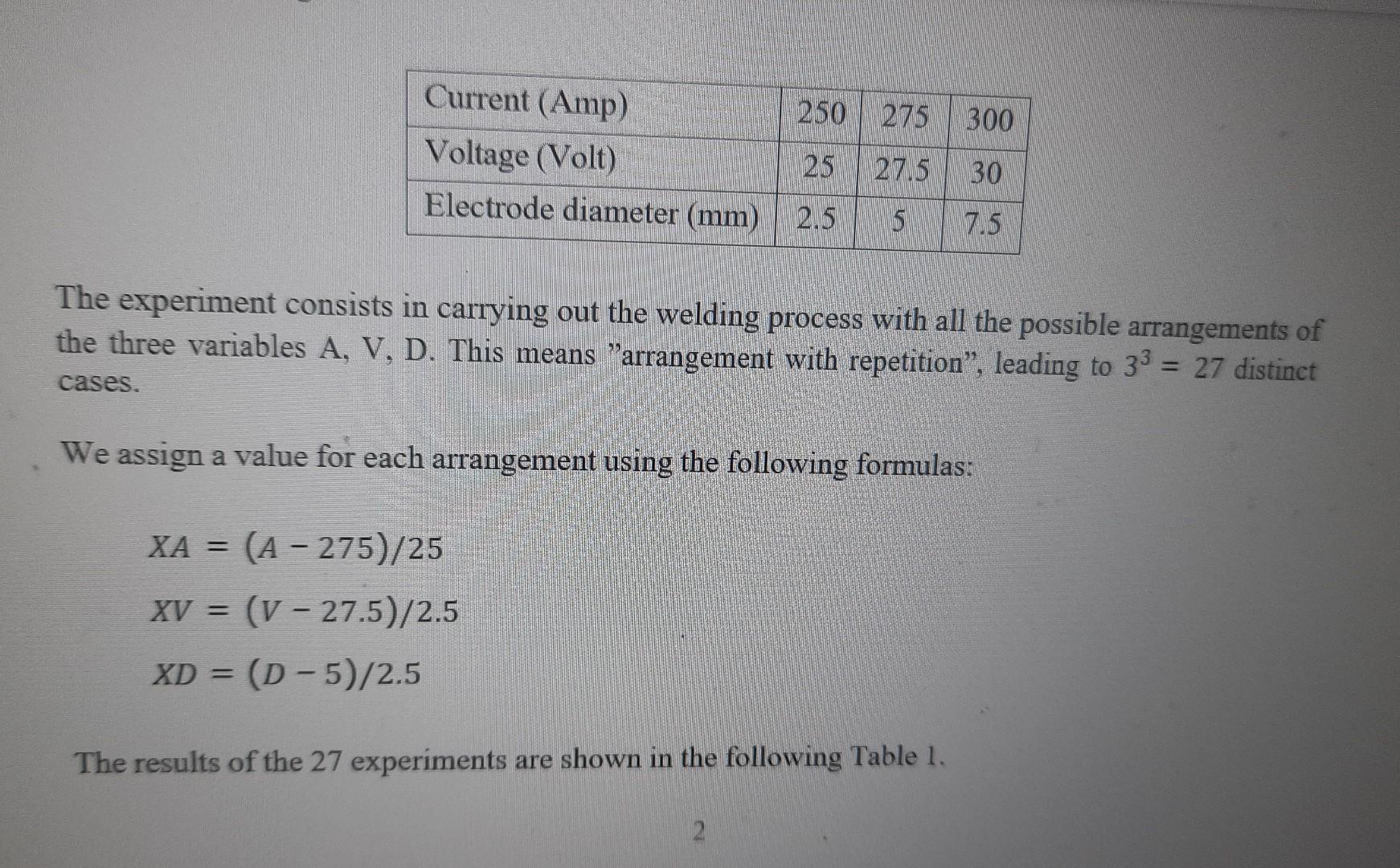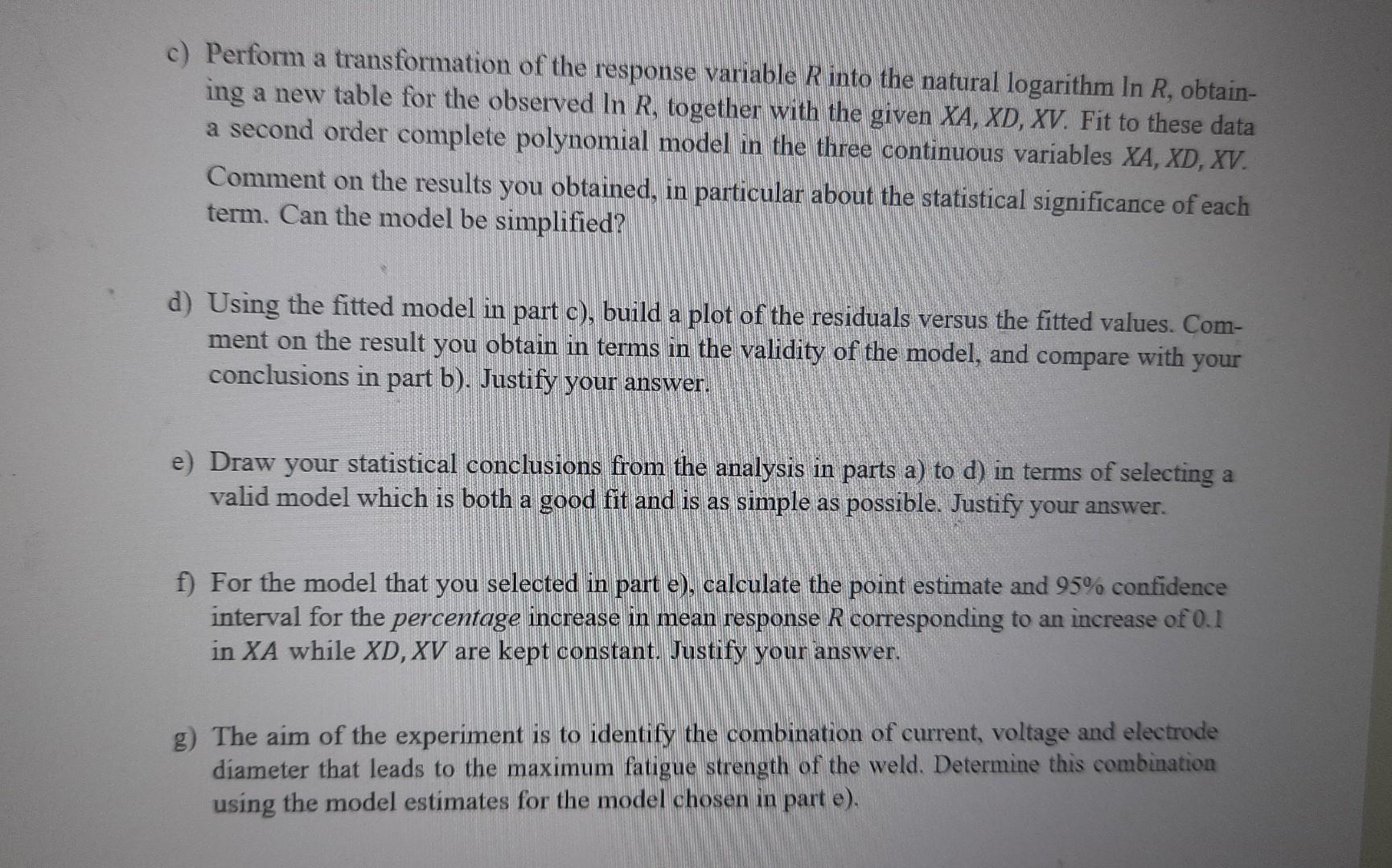Answered step by step
Verified Expert Solution
Question
1 Approved Answer
I need answers in R Programming An experiment is conducted to determine the optimal factors of a flux cored arc welding process for metals. Three





I need answers in R Programming
An experiment is conducted to determine the optimal factors of a flux cored arc welding process for metals. Three factors affect the tensile strength of welded joints: current, voltage and dimension of electrodes. The goal is to determine the settings that maximize the resistance to cycles of fatigue under prefixed load. The following shows the settings of the welding process. The variables are: 1) A= electrical current intensity (Ampere) 2) V= electrical voltage (Volt) 3) D= electrode diameter (mm) 4) R = fatigue resistance of the joint (cycles). The chosen setting are The experiment consists in carrying out the welding process with all the possible arrangements of the three variables A, V, D. This means "arrangement with repetition", leading to 33=27 distinct cases. We assign a value for each arrangement using the following formulas: XA=(A275)/25 The experiment consists in carrying out the welding process with all the possible arrangements of the three variables A, V, D. This means "arrangement with repetition", leading to 33=27 distinct cases. We assign a value for each arrangement using the following formulas: XA=(A275)/25XV=(V27.5)/2.5XD=(D5)/2.5 The results of the 27 experiments are shown in the following Table 1. Table 1 . Results of the experiment Recall that a complete second order polynomial in the variables x,y,z is a polynomial that contains all the terms in x,x2,y,y2,z,z2,xy,xz,yz. a) Fit a polynomial regression model to the data in Table 1 consisting of a complete second order polynomial model in the three continuous variables XA,XD,XV. Comment on the results you obtained, in particular about the statistical significance of each term. Can the model be simplified? Justify your answer. b) Using the fitted model in part a), build a plot of the residuals versus the fitted values. Comment on the result you obtain in terms in the validity of the model. Justify your answer. c) Perform a transformation of the response variable R into the natural logarithm lnR, obtaining a new table for the observed lnR, together with the given XA,XD,XV. Fit to these data a second order complete polynomial model in the three continuous variables XA,XD,XV. Comment on the results you obtained, in particular about the statistical significance of each term. Can the model be simplified? d) Using the fitted model in part c), build a plot of the residuals versus the fitted values. Comment on the result you obtain in terms in the validity of the model, and compare with your conclusions in part b). Justify your answer. e) Draw your statistical conclusions from the analysis in parts a) to d) in terms of selecting a valid model which is both a good fit and is as simple as possible. Justify your answer. f) For the model that you selected in part e), calculate the point estimate and 95% confidence interval for the percentage increase in mean response R corresponding to an increase of 0.1 in XA while XD,XV are kept constant. Justify your answer. g) The aim of the experiment is to identify the combination of current, voltage and electrode diameter that leads to the maximum fatigue strength of the weld. Determine this combination using the model estimates for the model chosen in part e). An experiment is conducted to determine the optimal factors of a flux cored arc welding process for metals. Three factors affect the tensile strength of welded joints: current, voltage and dimension of electrodes. The goal is to determine the settings that maximize the resistance to cycles of fatigue under prefixed load. The following shows the settings of the welding process. The variables are: 1) A= electrical current intensity (Ampere) 2) V= electrical voltage (Volt) 3) D= electrode diameter (mm) 4) R = fatigue resistance of the joint (cycles). The chosen setting are The experiment consists in carrying out the welding process with all the possible arrangements of the three variables A, V, D. This means "arrangement with repetition", leading to 33=27 distinct cases. We assign a value for each arrangement using the following formulas: XA=(A275)/25 The experiment consists in carrying out the welding process with all the possible arrangements of the three variables A, V, D. This means "arrangement with repetition", leading to 33=27 distinct cases. We assign a value for each arrangement using the following formulas: XA=(A275)/25XV=(V27.5)/2.5XD=(D5)/2.5 The results of the 27 experiments are shown in the following Table 1. Table 1 . Results of the experiment Recall that a complete second order polynomial in the variables x,y,z is a polynomial that contains all the terms in x,x2,y,y2,z,z2,xy,xz,yz. a) Fit a polynomial regression model to the data in Table 1 consisting of a complete second order polynomial model in the three continuous variables XA,XD,XV. Comment on the results you obtained, in particular about the statistical significance of each term. Can the model be simplified? Justify your answer. b) Using the fitted model in part a), build a plot of the residuals versus the fitted values. Comment on the result you obtain in terms in the validity of the model. Justify your answer. c) Perform a transformation of the response variable R into the natural logarithm lnR, obtaining a new table for the observed lnR, together with the given XA,XD,XV. Fit to these data a second order complete polynomial model in the three continuous variables XA,XD,XV. Comment on the results you obtained, in particular about the statistical significance of each term. Can the model be simplified? d) Using the fitted model in part c), build a plot of the residuals versus the fitted values. Comment on the result you obtain in terms in the validity of the model, and compare with your conclusions in part b). Justify your answer. e) Draw your statistical conclusions from the analysis in parts a) to d) in terms of selecting a valid model which is both a good fit and is as simple as possible. Justify your answer. f) For the model that you selected in part e), calculate the point estimate and 95% confidence interval for the percentage increase in mean response R corresponding to an increase of 0.1 in XA while XD,XV are kept constant. Justify your answer. g) The aim of the experiment is to identify the combination of current, voltage and electrode diameter that leads to the maximum fatigue strength of the weld. Determine this combination using the model estimates for the model chosen in part e)Step by Step Solution
There are 3 Steps involved in it
Step: 1

Get Instant Access to Expert-Tailored Solutions
See step-by-step solutions with expert insights and AI powered tools for academic success
Step: 2

Step: 3

Ace Your Homework with AI
Get the answers you need in no time with our AI-driven, step-by-step assistance
Get Started


